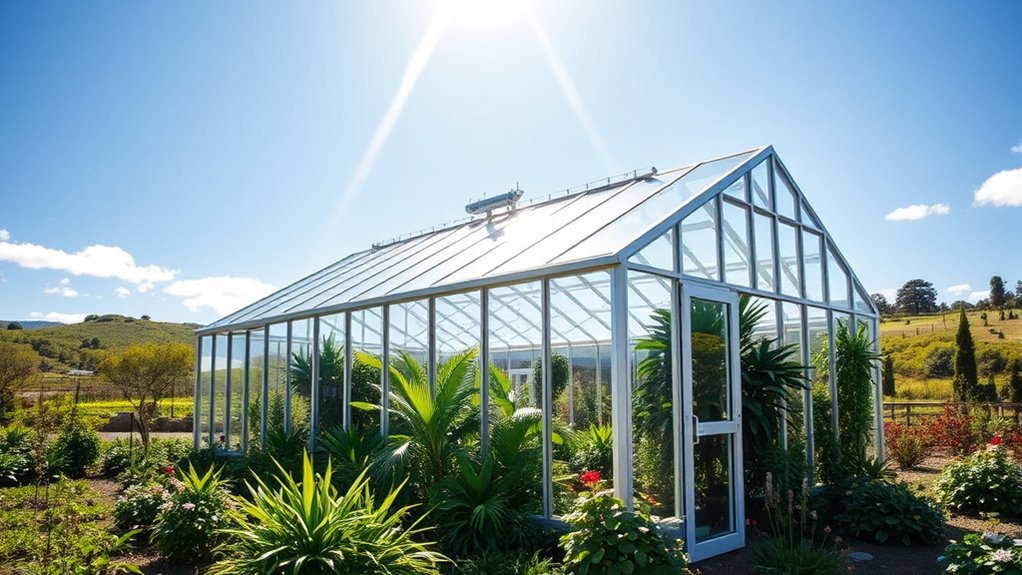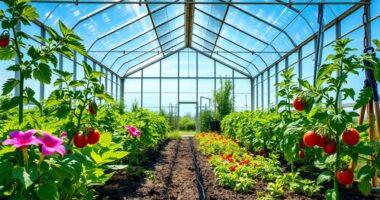You should use a greenhouse when outdoor conditions become less favorable for your plants, such as early spring or late fall, to extend your growing season. It’s ideal to start seedlings indoors and then move them into the greenhouse as temperatures fluctuate. During harsh weather or extreme cold snaps, a greenhouse provides a controlled environment to protect crops. Understanding your local climate helps you time its use effectively—keep exploring for more tips on optimizing your greenhouse use year-round.
Key Takeaways
- Use a greenhouse early in spring to start seedlings indoors and extend the growing season before outdoor conditions improve.
- Employ a greenhouse during unpredictable or extreme weather to protect plants from cold, rain, or wind.
- Supplement natural light with grow lights in winter to optimize plant growth during shorter days.
- Utilize a greenhouse in fall to prolong harvests and prevent early frosts from damaging crops.
- Adjust greenhouse use based on local climate patterns to maximize yields and maintain stable growing conditions year-round.

Timing is essential when it comes to using a greenhouse effectively, as it can profoundly impact plant growth and yield. Knowing the right moments to utilize your greenhouse allows you to maximize season extension and adapt to varying climate conditions. By carefully planning your greenhouse usage, you can start planting earlier in spring or extend your growing season into late fall, giving your crops a critical advantage over outdoor limitations.
Effective greenhouse use depends on timing to maximize growth and season extension.
For season extension, the key is to identify when outdoor conditions become less favorable for plant growth and then step in with your greenhouse. In cooler climates, you might want to start seedlings indoors or in a controlled environment before outdoor temperatures rise. Once the weather warms, you can gradually move your plants outside, but keep the greenhouse as a buffer to protect against unexpected cold snaps. Similarly, as fall approaches, you can keep growing crops longer by maintaining warm temperatures inside your greenhouse, allowing you to harvest crops well beyond their typical outdoor growing window. This strategic timing ensures you make the most of each growing season, avoiding premature crop loss due to early frosts or late cold spells.
Climate adaptation is another critical factor for determining when to use your greenhouse. If you live in an area with unpredictable weather or extreme temperature swings, you’ll want to monitor weather forecasts closely. Using your greenhouse as a climate buffer allows you to shield plants from harsh conditions, such as excessive rain, wind, or cold snaps. Timing your greenhouse use during adverse weather periods can help you maintain stable conditions, providing a controlled environment where plants can thrive despite external challenges. You might also use the greenhouse year-round if your climate is particularly severe, adjusting heat and humidity levels as needed to suit different crops and growth stages.
Another important consideration is the natural light cycle, which varies seasonally. In winter months, days are shorter, and sunlight is less intense, so you may need to supplement with grow lights or adjust your plant schedules accordingly. During summer, the greenhouse can trap heat, so ventilation becomes essential to prevent overheating. Additionally, understanding the best juice cleanses for weight loss can complement your gardening efforts by promoting overall wellness and energy. By aligning your greenhouse activities with seasonal and climatic shifts, you optimize plant health and productivity.
Ultimately, understanding when to use your greenhouse hinges on your local climate and seasonal patterns. Whether you’re extending the growing season or adapting to unexpected weather, timing your greenhouse use correctly allows you to grow more reliably, increase yields, and enjoy fresh produce year-round.
Frequently Asked Questions
How Does Local Humidity Affect Greenhouse Season Planning?
Your local humidity considerably impacts greenhouse season planning by influencing humidity control and microclimate management. High humidity can promote mold and pests, so you might need to enhance ventilation or dehumidifiers. Low humidity requires you to increase watering or use humidifiers. By actively managing humidity levels, you create a stable environment, extending growing seasons and ensuring healthy plant development regardless of external climate conditions.
Can Greenhouses Extend Growing Seasons in Tropical Climates?
You can absolutely extend your growing season in a tropical greenhouse, even when the weather seems perfect year-round. A tropical greenhouse allows you to control temperature and humidity, making season extension possible beyond natural limits. This means you can grow delicate plants or vegetables longer, enjoy fresh produce earlier or later, and maximize your gardening success. Don’t let the constant climate hold you back—use a greenhouse for true season extension.
What Are the Energy Considerations for Year-Round Greenhouse Use?
You should consider energy efficiency and solar insulation for year-round greenhouse use. To minimize energy costs, guarantee your greenhouse maximizes natural sunlight, using insulation materials that trap heat effectively. Proper ventilation and shading can also reduce energy needs. Investing in energy-efficient heating systems and possibly solar panels helps you maintain ideal temperatures sustainably, reducing reliance on external energy sources and making your greenhouse more eco-friendly and cost-effective throughout the year.
How Do Seasonal Daylight Variations Influence Greenhouse Plant Growth?
Seasonal daylight variations substantially impact your greenhouse plant growth through photoperiodism. Shorter days mean less natural light, so you should use artificial lighting to supplement daylight hours. This helps regulate flowering and vegetative growth. By adjusting light duration and intensity, you can optimize plant development year-round, ensuring healthy growth regardless of seasonal changes. Proper lighting management allows you to control growth cycles even during the darkest months.
Are There Specific Climate Zones Better Suited for Greenhouse Gardening?
Certain climate zones, like temperate or subtropical regions, are better suited for greenhouse gardening because you can control soil temperature and pest management more effectively. In cooler zones, a greenhouse helps maintain warmth, extending your growing season. Conversely, in warmer zones, it shields plants from pests and extreme weather. By choosing the right climate zone, you optimize plant growth and reduce issues related to soil temperature fluctuations and pest problems.
Conclusion
Just like a wise gardener knows when to plant and when to wait, understanding the right time to use your greenhouse guarantees lush, healthy crops. By considering your season and climate, you can turn your greenhouse into a sanctuary of growth year-round. Remember, every season has its own story—your greenhouse is the chapter where your plants thrive, no matter the weather outside. Master the timing, and watch your garden flourish like a well-kept secret.








